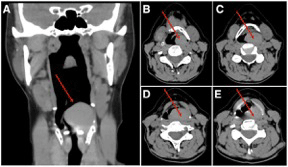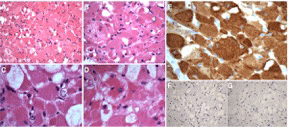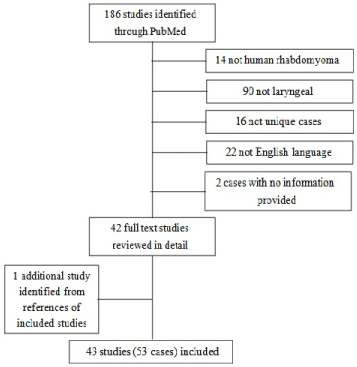
Case Report
Ann Hematol Oncol. 2017; 4(2): 1135.
Asymptomatic Rhabdomyoma of the Larynx: Case Report and Review of the Literature
Ahmed HS¹, Parikh AS², Srikanth P², Tjoa T³, Faquin WC4 and Lin DT²*
¹Harvard Medical School, USA
²Department of Otolaryngology, Massachusetts Eye and Ear Infirmary, USA
³Department of Otolaryngology, University of California Irvine, USA
4Department of Pathology, Massachusetts Eye and Ear Infirmary, USA
*Corresponding author: Lin DT, Department of Otolaryngology, Massachusetts Eye and Ear Infirmary, 243 Charles Street, Boston, MA 02114, USA
Received: January 09, 2017; Accepted: February 13, 2017; Published: February 17, 2017
Abstract
Rhabdomyoma of the head and neck is an uncommon tumor. Tumor occurrence in the larynx is particularly rare, with only 53 reported cases. We describe the case of a 59-year-old woman with an asymptomatic, incidentally discovered adult type rhabdomyoma of the left aryepiglottic fold, successfully treated with endoscopic resection. We also conduct a comprehensive review of the literature, including operative management and surgical outcomes. Of 53 cases reviewed, the mean age at diagnosis was 33.8 years and a 2.4:1 male predominance was observed. The most common presenting symptom was hoarseness, and the most common site of origin was the true vocal fold. Endoscopic and open resection were used at similar rates, and there were no obvious differences in patient characteristics by surgical approach. However, a higher recurrence rate and shorter time to recurrence were observed with endoscopic resection, as compared with open resection. Thus, we suggest the potential downside of endoscopic management that must be balanced with the potential for significantly lower morbidity and ease of re-resection when considering the appropriate surgical approach for a given patient.
Keywords: Larynx; Rhabdomyoma; Laryngeal neoplasms
Introduction
Rhabdomyomas are extremely rare benign neoplasms of striated muscle and comprise less than 2% of all skeletal muscle tumors [1]. Most extracardiac rhabdomyomas occur in the head and neck, specifically the oropharynx, larynx, pharyngeal constrictor muscles, submandibular region, base of the tongue, and less commonly lip, lateral neck, soft palate, uvula, cheek, and orbit [2-6].
Rhabdomyomas of the head and neck are slow-growing and wellcircumscribed; malignant transformation is rare [4,7]. Treatment generally involves surgical excision of the lesion, preventing invasion of surrounding tissues and obstruction of the airway or esophageal inlet. Although treatment is typically curative, these lesions do occasionally recur. Histologically, rhabdomyomas are divided into two types: neoplastic and hamartoma [8]. Neoplastic rhabdomyomas are further classified into adult, fetal, and genital (or vaginal) subtypes [8]. Adult type rhabdomyomas are characterized by sheets of closelypacked polygonal vacuolated (glycogen-containing) cells with granular eosinophilic cytoplasm, with occasional cross-striations and prominent nucleoli [2,3]. Fetal cellular type is characterized by immature skeletal muscle elements at varying stages of differentiation [2], while genital cellular type appears as a mixture of fibroblast-like cells with clusters of mature cells with cross-striations and collagenand mucoid-rich matrix [3].
Clinically, adult type rhabdomyomas occur in the soft tissues of the head and neck in 70 to 93% of cases; the fetal subtype is most prevalent in children, and the genital (also known as vaginal) type is typically a polypoid mass found in the vagina and vulva of middle-aged women [3,4,6]. The most common presenting symptoms for the adult type are hoarseness, dyspnea, and dysphagia [3,4]. Fetal type rhabdomyomas present with obstructive and constrictive oropharyngeal symptoms, and the genital type is typically asymptomatic but presents with dyspareunia [3,9].
Here, we describe the case of an incidentally discovered adult rhabdomyoma of the larynx in a 59-year-old woman. We also systematically review 53 cases of laryngeal rhabdomyoma reported in the literature, which to our knowledge, has not been done previously.
Case Presentation
The patient is 59-year-old woman with a 40 pack year smoking history who presented to her primary care physician for routine care. Given her extensive smoking history, a screening chest CT was ordered and demonstrated a left upper lobe lung mass. Subsequent PET-CT showed this lung mass, as well as an incidental 3.2 cm left supraglottic laryngeal mass, and the patient was referred to otolaryngology. Fiberoptic laryngoscopy showed a large obstructing left arytenoid mass with normal overlying mucosa. Dedicated neck CT showed a well-circumscribed, oval, left supraglottic mass measuring 3.3x2.8x1.8 cm, centered in the left piriform sinus and along the left aryepiglottic fold, without involvement of the true vocal folds (Figure 1).

Figure 1: CT neck showing left supraglottic mass on coronal (A) and axial
(B-E) sections.
The patient underwent direct laryngoscopy with biopsy and at that time, and an elective tracheotomy was performed due to concern for airway obstruction from the mass. The biopsy showed large polygonal tumor cells, with immunohistochemistry strongly positive for desmin and negative for keratin, S-100, Sox-10, NSE, and CD68, consistent with a diagnosis of adult rhabdomyoma. The patient underwent endoscopic surgical resection, with a combination of laryngeal microscissors, OmniGuide CO2 laser, and microdebrider (Figure 2). A complete resection was achieved, with the area of attachment to the left aryepiglottic fold free of gross disease. Final pathology was consistent with the initial biopsy specimen (Figure 3). The patient had no evidence of tumor recurrence at a 9 month follow up visit. Regarding her lung mass, she also underwent left upper lobectomy, which revealed stage I non-small cell lung cancer.

Figure 2: Intra-operative image showing large, well-circumscribed mass
arising from left aryepiglottic fold.

Figure 3: Hematoxylin and eosin staining of adult rhabdomyoma showing
large polygonal vacuolated cells with eosinophilic cytoplasm (A, B), with
occasional cross-striations (C) and prominent nucleoli (D). Immunostating
of adult rhabdomyoma showing positive desmin immunoreactivity (E) and
negative synaptophysin (F) and S-100 (G) and immunoreactivity.
Discussion and Conclusion
We describe the case of an asymptomatic, incidentally-discovered rhabdomyoma of the supraglottic larynx, arising from the left aryepiglottic fold. We also perform a comprehensive review the literature using the MEDLINE database as indexed by PubMed. The MEDLINE database was searched using the terms “rhabdomyoma larynx,” “laryngeal rhabdomyoma,” and “rhabdomyoma head neck.” A total of 186 entries were screened by title and abstract. Articles were excluded if they were not human rhabdomyoma (14), not laryngeal (90), not unique cases (13), or not English-language (22). In addition, one case was added based on references from articles obtained from the above searches [2]. A total of 53 cases were included (Figure 4) (Table 1).

Figure 4: Flow diagram of included studies.
Age/ Sex
Site
Symptom(s)
Treatment
Type
Size (cm)
Follow-up/Outcome
23M
TVF
Hoarseness
Endoscopic excision
Fetal
1.5
No recurrence after 1 yr
39F
FVF to subglottis
Hoarseness
Laryngofissure
NS
3
No follow up reported
82M
TVF
Hoarseness
None (found at autopsy)
Adult
1
No recurrence at 20 yr
48M
TVF
Hoarseness
Endoscopic excision
Adult
1
No recurrence at 1 yr
55M
FVF to subglottis
Hoarseness
Laryngofissure
Adult
5
No follow up reported
36F
Ventricle
Hoarseness
Laryngofissure
Adult
1.5
No follow up reported
50M
Interarytenoid region
Hoarseness, dysphonia
Endoscopic excision
Fetal
1.5
No recurrence at 1 yr
52F
FVF
Hoarseness
Endoscopic excision
Adult
0.5
No recurrence after 7 mo
39M
TVF
Hoarseness
Endoscopic excision
Adult
0.5
Local resections for recurrences at 2, 7, 11 mo
55M
FVF
Not reported
Endoscopic excision
Adult
2.5
No recurrence at 2 yr
64F
Ventricle
Hoarseness, globus
Endoscopic excision
Adult
1.5
No recurrence at 3 mo
16M
TVF, thyroid cartilage
Airway obstruction
Total laryngectomy
Adult
2
No recurrence at several yr
76F
TVF
Hoarseness
Endoscopic excision
Adult
0.75
No recurrence at 2 yr
53M
TVF
Hoarseness
Open excision
Fetal
NS
No recurrence at 3.5 yr
65F
TVF
Hoarseness
Open excision
Fetal
NS
No recurrence at 1.5 yr
58M
AE fold, pyriform sinus
Dysphagia, globus
Transhyoidpharyngotomy
Adult
3
No recurrence at 2 yr
34F
Anterior TVF
Hoarseness
Endoscopic excision
Fetal
3
Two recurrences; lateralpharyngotomy then supraglotticlaryngectomy at 7 mo, no recurrence at 3 yr
60M
Ventricle
Not reported
Unspecified
Adult
15
No follow up reported
31M
FVF
Hoarseness
Lateral thyrotomy
Fetal
3
No recurrence at 1 yr
78F
Posterior TVF
Hoarseness
Endoscopic excision
Fetal
0.6
No recurrence at 2 yr
52M
TVF
Hoarseness
Lateral pharyngotomy
Adult
1.5
No recurrence at 18 mo
66M
Inferior to TVF
Hoarseness
Unspecified
Adult
3
No follow up reported
44M
Posterior TVF
Sore throat
Unspecified
Fetal
0.5
No follow up reported
29M
FVF
Hoarseness
Unspecified
Fetal
1.2
No recurrence at 2 yr
51F
Arytenoid
Dyspnea, dysphagia
Lateral pharyngotomy
Adult
4
Resection for recurrence 12 yr, no recurrence at 2 yr
15 mo F
Subglottis
Dysphagia, stridor
Open excision
Adult
2
No recurrence after 6 mo
32M
Larynx
Not reported
Unspecified
Adult
NS
No follow up reported
59M
Larynx
Hoarseness
Unspecified
Adult
NS
No recurrence at 5 yr
59M
BOT, phayrnx, larynx
Airway obstruction
Unspecified
Adult
NS
No recurrence at 10 yr
60M
Larynx
Airway obstruction
Unspecified
Adult
1.5
No recurrence at 2 yr
54M
Larynx, hypopharynx
Airway obstruction
Unspecified
Adult
NS
No recurrence at 2 yr
56F
Interarytenoid region
Dyspnea, dysphagia
Endoscopic excision
Adult
2.5
Recurrence resected, date unknown, no recurrence at 1 yr
31F
TVF
Dysphonia
Unspecified
Adult
NS
No follow up reported
51M
Ventricle
Hoarseness
Hemilaryngectomy
Adult
7.5
No recurrence at 1 yr
64M
AE fold
Asymptomatic
Lateral pharyngotomy
Adult
5
Lateral pharyngotomy for recurrence at 2 mo, contralateral pharyngotomy for recurrence at 7 yr
69F
TVF
Hoarseness
Endoscopic excision
Adult
NS
No recurrence at 6 mo
39M
AE fold, TVF
Dysphagia, aspiration
Unspecified
Adult
NS
No follow up reported
66M
Arytenoid
Hoarseness, dysphagia
Open excision
Adult
NS
No recurrence
81M
TVF
None (incidental finding)
Laryngectomy for SCC
Adult
0.04
No follow up reported
79M
FVF
Hoarseness
Open excision
Adult
2
No recurrence at 6 weeks
69M
Epiglottis
None
Unspecified
Adult
2.8
No follow up reported
66M
Arytenoid
Dysphagia, obstruction
Endoscopic excision
Adult
2
No recurrence at 18 mo
72F
AE fold
Hoarseness, globus
Transoral laser excision
Adult
3.5
No follow up reported
76M
Arytenoid
Hoarseness, dysphagia
Laser debulking
Adult
3.5
Recurrences at 5, 9 mo
68M
Supraglottis
Dysphagia, globus
Open excision
Adult
5.5
No recurrence at 10 mo
NS
Glottis
Dysphonia
Endoscopic excision
NS
NS
No follow up reported
67F
Supraglottis
Hoarseness, dyspnea
Hemilaryngectomy
Adult
3
No recurrence at 16 mo
55M
Supraglottis
Hoarseness, dysphagia
Endoscopic excision
Adult
8.5
Recurrence at 3 mo
35M
Supraglottis
Hoarseness
Endoscopic excision
Adult
NS
No recurrence at 15 mo
42M
TVF
Hoarseness
Endoscopic excision
Fetal
0.5
No follow up reported
11M
Supraglottis, TVF
Dysphonia, stridor
Endoscopic excision
Fetal
1.6
No recurrence at 5 yr
75M
TVF
Hoarseness
Endoscopic excision
Adult
2.2
No recurrence at 1 yr
59F†
AE fold
None
Endoscopic excision
Adult
3.3
No recurrence at 9 mo
TVF: True Vocal Fold; AE: Aryepiglottic; FVF: False Vocal Fold; NS: Not Stated; yr: year; mo: months
†Current report
Table 1: Laryngeal rhabdomyomas previously described in literature.
Patients with laryngeal rhabdomyoma are most commonly middle-aged men presenting with hoarseness [7]. Other presenting symptoms include dysphagia [7], dyspnea [10], dysphonia [11], and rarely stridor [11], aspiration [12], and airway obstruction [13]. Mean age at diagnosis was 33.8 years (range 1.25 to 82 yrs), with a 2.4:1 male predominance. 40/53 cases (75%) were adult rhabdomyomas, 11/53 (21%) were fetal type, 2/53 (4%) did not report a type. The most common subsites were the true vocal fold (20/53 cases, 38%), false vocal fold (7/53 cases, 13%), and the aryepiglottic fold (5/53 cases, 9%).
On biopsy, histopathology typically demonstrates large closelypacked polygonal cells that often have a spiderweb-like appearance [14,15]. Immunohistochemically, rhabdomyomas stain positively for myoglobin, desmin, and myo-D1, with occasionally positive musclespecific actin. Immunoreactivity for smooth muscle actin, S-100 protein, vimentin, Leu-7 and cytokeratin are typically negative. There is typically no immunoreactivity for epithelial markers, chromogranin, synaptophysin, glial fibrillary acidic protein, or CD68 (KP-1), and the expression of proliferation marker ki-67 is low, consistent with the indolent, slow-growing nature of these tumors. Electron microscopy typically shows thin and thick myofilaments with Z-band material [14,15]. An accurate diagnosis can be made due to the characteristic microscopic appearance and immunohistochemical staining. Our patient’s histopathology and immunostaining are consistent with the diagnosis of adult type rhabdomyoma.
Patients with laryngeal rhabdomyoma are generally treated surgically. Of the cases reported in the literature, 18/53 patients (34%) had open resections, while 22/53 patients (42%) had endoscopic resections; there were 13 additional cases for which the surgical details were not reported. Patients who underwent open resection tended to have slightly larger lesions (average size 2 cm vs. 1.6 cm for lesions resected endoscopically), but this difference was not statistically significant. There was no obvious difference in resection technique by age, subsite, or presenting symptom. Of patients who underwent open resection, 2/18 (11%) recurred, while of those who underwent endoscopic resection, 5/22 (23%) recurred. Moreover, the average time to recurrence in patients treated with open surgery was 6.1 years, while in patients treated endoscopically, it was 4.3 months.
Although this sample is small and heterogeneous, these data suggest anecdotally that there may be a higher recurrence rate with endoscopic resection than with open resection. However, this consideration must be balanced with the increased morbidity of an open resection, as well as the relative ease of repeat endoscopic resection when necessary, particularly given the benign nature of these lesions. Moreover, although these lesions do occasionally cause airway obstruction they typically present with other symptoms first and may be readily caught at an early stage with routine surveillance. Thus, endoscopic resection should still be considered when possible but given the potentially increased rate of and accelerated time to recurrence, frequent surveillance should be considered, particularly in the early postoperative period.
References
- Papaspyrou G, Werner JA, Roeßler M, Devaney KO, Rinaldo A, Ferlito A. Adult rhabdomyoma in the parapharyngeal space: report of 2 cases and review of the literature. Am J Otolaryngol. 2011; 32: 240-246.
- Imperatori CJ. Rhabdomyoma of the larynx. Report of a case. The Laryngoscope. 1933; 43: 945-948.
- Enzinger FM, Weiss SW. Rhabdomyoma. In: Enzinger FM, Weiss SW, eds. Soft tissue tumors, 3rd ed. St. Louis: Mosby; 1995; 523-536.
- Kapadia SB, Meis JM, Frisman DM, Ellis GL, Heffner DK, Hyams VJ. Adult rhabdomyoma of the head and neck: a clinicopathologic and immunophenotypic study. Hum Pathol. 1993; 24: 608-617.
- Bastian BC, Bröcker EB. Adult rhabdomyoma of the lip. Am J Dermatopathol. 1998; 20: 61-64.
- Knowles DM, Jakobiec FA. Rhabdomyoma of the orbit. American journal of ophthalmology. 1975; 80: 1011-1018.
- Koutsimpelas D, Weber A, Lippert BM, Mann WJ. Multifocal adult rhabdomyoma of the head and neck: a case report and literature review. Auris Nasus Larynx. 2008; 35: 313-317.
- Leon Barnes, John W. Eveson, Peter Reichart DS. WHO Classification of Tumours. Pathol Genet Head Neck Tumours. 2005; 209-281.
- Montgomery EA. Biopsy interpretation of the gastrointestinal tract mucosa. Lippincott Williams & Wilkins. 2006.
- Pichi B, Manciocco V, Marchesi P, Pellini R, Ruscito P, Vidiri A, et al. Rhabdomyoma of the parapharyngeal space presenting with dysphagia. Dysphagia. 2008; 23: 202-204.
- Elawabdeh N, Sobol S, Blount AC, Shehata BM. Unusual presentation of extracardiac fetal rhabdomyoma of the larynx in a pediatric patient with tuberous sclerosis. Fetal Pediatr Pathol. 2013; 32: 43-47.
- Liang GS, Loevner LA, Kumar P. Laryngeal rhabdomyoma involving the paraglottic space. Am J Roentgenol. 2000;174:1285-1287.
- Jensen K, Swartz K. A rare case of rhabdomyoma of the larynx causing airway obstruction. Ear Nose Throat J. 2006; 85: 116-118.
- Weiss SW, Goldblum JR. Osseous soft tissue tumors. Weiss SW, Goldblum JR. Enzinger and Weiss Soft Tissue Tumors. 2001.
- Wenig BM. Atlas of head and neck pathology. Elsevier Health Sciences. 2015.